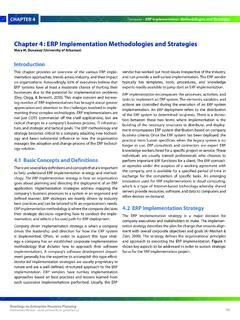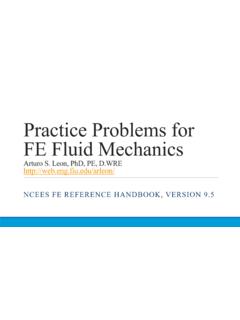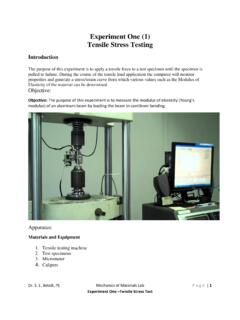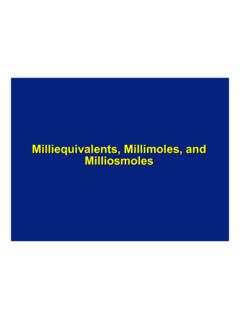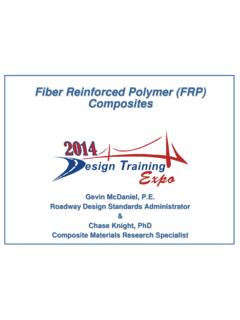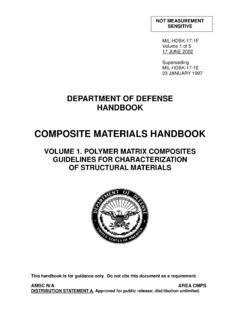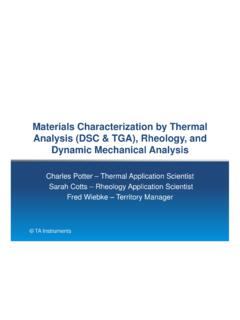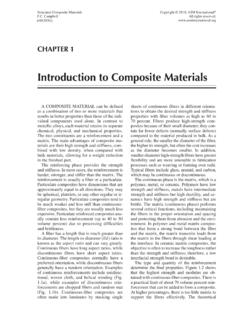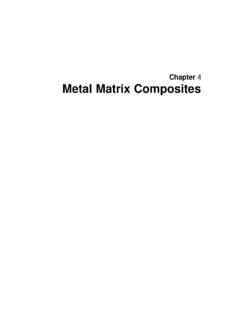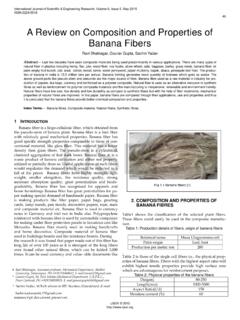Transcription of Chapter 16: Composite Materials
1 ISSUES TO What are the classes and types of composites? Why are composites used instead of metals,ceramics, or polymers? Chapter 16: Composite MaterialsChapter 16 -1ceramics, or polymers? How do we estimate Composite stiffness & strength? What are some typical applications?Composites Combine Materials with the objective of getting a more desirable combination of properties Ex: get flexibility & weight of a polymer plus the strength of a ceramic structure Materials for aircraft engine: low densities, strong, stiff, abrasion and impact resistant and corrosion 16 -2corrosion engine: Principle of combined action Mixture gives averaged propertiesbetter property combinations are fashioned by the combination of 2 or more distinct Materials . Composite is considered to be any multiphase Materials that exhibits a significant proportion of the properties of both constituent phases such that a better combination of properties is 16 -3 Schematic representations of the various geometrical and spatial characteristics of particles of the dispersed phase that may influence the properties of composites: (1) concentration, (b) size, shape, (d) distribution, and (e) orientation.
2 Composites:-- Multiphase material w/significantproportions of each phase. matrix :-- The continuous phase-- Purpose is to:- transfer stress to other phasesTerminology/Classificationwoven fiberscross mmChapter 16 -4 Dispersed phase:-- Purpose: enhance matrix : increase sy, TS, creep : increase KcPMC: increase E, sy, TS, creep Classification: Particle, fiber, structural- protect phases from environment-- Classification: MMC, CMC, PMCmetalceramicpolymerReprinted with permission fromD. Hull and Clyne, An Introduction to Composite Materials , 2nd ed., Cambridge University Press, New York, 1996, Fig. , p. section mmComposite SurveyLarge-particleDispersion-strengthe nedParticle-reinforcedContinuous(aligned )Discontinuous(short)Fiber-reinforcedLam inatesSandwichpanelsStructuralComposites Chapter 16 -5 AlignedRandomlyorientedAdapted from Fig. , Callister 7e. 10-100nmComposite Survey: Particle-I Examples:Adapted from Fig. , Callister 7e.
3 (Fig. is copyright United States Steel Corporation, 1971.)- Spheroidite steelmatrix: ferrite (a)(ductile)particles: cementite(Fe3C) (brittle)60mmParticle-reinforcedFiber-re inforcedStructuralChapter 16 -6 Adapted from Fig. , Callister 7e. (Fig. is courtesy Carboloy Systems, Department, General Electric Company.)- WC/Co cemented carbidematrix: cobalt (ductile)particles: WC (brittle, hard)Vm:10-15 vol%!600mmAdapted from Fig. , Callister 7e. (Fig. is courtesy Goodyear Tire and Rubber Company.)- Automobile tiresmatrix: rubber (compliant)particles: C (stiffer) Survey: Particle-IIConcrete gravel + sand + cement- Why sand andgravel? Sand packs into gravel voids Reinforced concrete -Reinforce with steel rerod or remesh-increases strength -even if cement matrix is crackedParticle-reinforcedFiber-reinforc edStructuralChapter 16 -7-increases strength -even if cement matrix is crackedPrestressed concrete -remesh under tension during setting of concrete.
4 Tension release puts concrete under compressive force-Concrete much stronger under compression. - Applied tension must exceed compressive forcethreadedrodnutPost tensioning tighten nuts to put under 16 -8 Fractured reinforced concreteChapter 16 -9 How prestressed concrete is made ?High strength steelThe prestressing strand is stretched across the casting bed, 30000 pounds of tension will be appliedA tarp is placed over and heat is appliedChapter 16 -10 Cement, sand, stone, and water make up concreteThe prestressing strands are cut and removed from the casting bedPost-tensioning Post-tensioning is the method of achieving pre-stressing after the concrete has hardened and takes advantage of concrete's inherent compressive strength. Concrete is exceptionally strong in compression, but generally weak when subjected to tension forces or forces that pull it tension forces can be created by Chapter 16 -11generally weak when subjected to tension forces or forces that pull it tension forces can be created by concrete shrinkage caused during curing or by flexural bending when the foundation is subjected to design loads (dead and live loads from the structure and/or expansive soil induced loads).
5 This tension can result in cracking which can lead to large deflections that can cause distress in the building's structure. The application of an external force into the concrete, recompressing it before it is subjected to the design loads, makes the foundation less likely to Elastic modulus, Ec, of composites:-- two from Fig. , Callister 7e. (Fig. is Composite Survey: Particle-IIIlower limit:cmmupper limit:E=VE+VpEp rule of mixtures Particle-reinforcedFiber-reinforcedStruc turalData: Cu matrix 300350E(GPa) Chapter 16 -12 Application to other properties :--Electrical conductivity, se: Replace Ein equations with conductivity, k: Replace Ein equations with 7e. (Fig. is from Krock, ASTM Proc, Vol. 63, 1963.)lower limit:1Ec=VmEm+VpEpCu matrix w/tungsten particles02040608010 015020 0250300vol% tungsten(Cu)(W) Composite Survey: Fiber-I Fibers very strong Provide significant strength improvement to material Ex: fiber-glassParticle-reinforcedFiber-rein forcedStructuralChapter 16 -13 Continuous glass filaments in a polymer matrix Strength due to fibers Polymer simply holds them in placeInfluence of fiber Materials , orientation, concentration, length, etcComposite Survey: Fiber-II Fiber Materials Whiskers- Thin single crystals - large length to diameter ratio graphite, SiN, SiC high crystal perfection extremely strong, strongest known very expensiveParticle-reinforcedFiber-reinfo rcedStructuralChapter 16 -14 Fibers polycrystalline or amorphous generally polymers or ceramics Ex: Al2O3, Aramid, E-glass, Boron, UHMWPE Wires Metal steel, Mo, WFiber AlignmentAdapted from Fig.)
6 , Callister 7e. Chapter 16 -15alignedcontinuousaligned randomdiscontinuous Aligned Continuousfibers Examples:--Metal: g'(Ni3Al)-a(Mo)by eutectic Survey: Fiber-IIIP article-reinforcedFiber-reinforcedStruct uralmatrix: a (Mo) (ductile) --Ceramic: Glass w/SiC fibersformed by glass slurryEglass= 76 GPa; ESiC= 400 16 -16 From W. Funk and E. Blank, Creep deformation of Ni3Al-Mo in-situ composites", Metall. Trans. AVol. 19(4), pp. 987-998, 1988. Used with :g (Ni3Al) (brittle)2mm(a)(b)fracture surfaceFrom Matthews and Rawlings, Composite Materials ; Engineering and Science, Reprint ed., CRC Press, Boca Raton, FL, 2000. (a) Fig. , p. 145 (photo by J. Davies); (b) Fig. , p. 349 (micrograph by Kim, Rodgers, and Rawlings). Used with permission of CRCP ress, Boca Raton, FL. Discontinuous, random 2 Dfibers Example:Carbon-Carbon-- process: fiber/pitch, thenburn out at up to 2500 uses: disk brakes, gas turbine exhaust flaps, noseComposite Survey: Fiber-IVParticle-reinforcedFiber-reinfor cedStructural(b)C fibers: very stiff very strongC matrix : less stiff Chapter 16 -17turbine exhaust flaps, nosecones.
7 Other variations:--Discontinuous, random 3D--Discontinuous, 1 DAdapted from Matthews and Rawlings, Composite Materials ; Engineering and Science, Reprint ed., CRC Press, Boca Raton, FL, 2000. (a) Fig. (a), p. 151; (b) Fig. (b) p. 151. (Courtesy Davies) Reproduced with permission of CRC Press, Boca Raton, lie in planeview onto planeless stiff less strong(a)Boeing 787 Carbon fiber-reinforced polymer composites Critical fiber length for effective stiffening & strengthening: Ex: For fiberglass, fiber length > 15 mm neededComposite Survey: Fiber-VParticle-reinforcedFiber-reinforc edStructuralcfdts>15length fiberfiber diametershear strength offiber- matrix interfacefiber strength in tensionChapter 16 -18 Ex: For fiberglass, fiber length > 15 mm needed Why? Longer fibers carry stress more efficiently!Shorter, thicker fiber:cfdts<15length fiberLonger, thinner fiber:Poorer fiber efficiencyAdapted from Fig. , Callister >15length fiberBetter fiber efficiencys(x)s(x)Load transmittance: the magnitude of the interfacial bond between the fiber and matrix phaseComposite Strength:Longitudinal LoadingContinuous fibers-Estimate fiber-reinforced Composite strength for long continuous fibers in a matrix Longitudinal deformationsc= smVm+ sfVfbut ec= em= efChapter 16 -19volume fraction isostrain\Ece= EmVm+ EfVflongitudinal (extensional)modulus mmffmfVEVEFF=f= fiberm= matrixModulus of elasticityComposite Strength:Transverse Loading In transverse loading the fibers carry less of the load - isostresssc= sm= sf= sec= emVm+ efVfVV1\ Chapter 16 -20ffmmctEVEVE+=1transverse modulus\ Estimate of Ecand TSfor discontinuous fibers:-- valid when-- Elastic modulus in fiber direction: Composite Strengthcfdts>15length fiberParticle-reinforcedFiber-reinforced StructuralE= EV+ KEVC hapter 16 -21--TSin fiber direction: efficiency factor.
8 -- aligned 1D: K= 1 (aligned )-- aligned 1D: K= 0 (aligned )-- random 2D: K= 3/8 (2D isotropy)-- random 3D: K= 1/5 (3D isotropy)(aligned 1D)Values from Table , Callister 7e. (Source for Table is H. Krenchel, Fibre Reinforcement, Copenhagen: Akademisk Forlag, 1964.)(TS)c= (TS)mVm+ (TS)fVfEc= EmVm+ KEfVfComposite Production Methods-I Pultrusion Continuous fibers pulled through resin tank, then performing die & oven to cureChapter 16 -22 Adapted from Fig. , Callister 7e. Composite Production Methods-II Filament Winding Ex: pressure tanks Continuous filaments wound onto mandrelAdapted from Fig. , Callister 7e. [Fig. is from N. L. Hancox, (Editor), Fibre Chapter 16 is from N. L. Hancox, (Editor), Fibre Composite Hybrid Materials , The Macmillan Company, New York, 1981.] Stacked and bonded fiber-reinforced sheets-- stacking sequence: , 0 /90 -- benefit: balanced, in-plane stiffnessAdapted from Fig. , Callister Survey: StructuralParticle-reinforcedFiber-reinf orcedStructural Sandwich panelsA structural Composite is normally composed of both homogeneous and Composite 16 -24 Sandwich panels-- low density, honeycomb core-- benefit: small weight, large bending stiffnesshoneycombadhesive layerface sheetAdapted from Fig.
9 ,Callister 7e. (Fig. isfrom Engineered MaterialsHandbook, Vol. 1, Composites, ASM International, Materials Park, OH, 1987.) CMCs:Increased toughnessComposite Benefitsfiber-reinfun-reinfparticle-rein fForce PMCs:Increased E/rE(GPa)G=3 metal alloyspolymersPMCsceramicsChapter 16 -25 Bend displacementG=3E/8K=EDensity, r[mg/m3]. from Nieh, "Creep rupture of a silicon-carbide reinforced aluminum Composite ", Metall. Trans. AVol. 15(1), pp. 139-146, 1984. Used with permission. MMCs:Increasedcreepresistance2030 50100 20010-1010-810-610-46061 Al6061 Al w/SiC whiskerss(MPa)ess(s-1) Composites are classified according to:-- the matrix material (CMC, MMC, PMC)-- the reinforcement geometry (particles, fibers, layers). Composites enhance matrix properties :-- MMC: enhance sy, TS, creep performance-- CMC: enhance Kc--PMC: enhance E, sy, TS, creep performanceSummaryChapter 16 -26--PMC: enhance E, sy, TS, creep performance Particulate-reinforced:-- Elastic modulus can be properties are isotropic.
10 Fiber-reinforced:-- Elastic modulus and TScan be estimated along fiber properties can be isotropic or anisotropic. Structural:-- Based on build-up of sandwiches in layered form.

